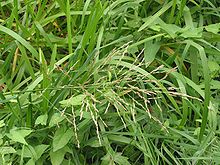Water plumes
| Water plumes | ||||||||||||
|---|---|---|---|---|---|---|---|---|---|---|---|---|

Water plumes ( Glyceria maxima ); Figure left; right flooding plumes ( Glyceria fluitans ) |
||||||||||||
| Systematics | ||||||||||||
|
||||||||||||
| Scientific name | ||||||||||||
| Glyceria maxima | ||||||||||||
| ( Hartm. ) Holmb. |
The water swath ( Glyceria maxima (Hartm.) Holmbg. , Syn .: Glyceria aquatica Wahlenb. ), Also called large swath , large water swath or giant swath , belongs to the family of sweet grasses . The lush "water grass" often forms extensive pure stands in swampy areas.
description
The water swath is a very large, about 80 to 150, sometimes up to 200 centimeters high, perennial herbaceous plant with wide creeping, strong rhizomes . It forms extensive shoot colonies with numerous non-flowering, strong and upright vegetative shoots. The stalks are round and up to 1 centimeter in diameter. The leaves are bare and rough. The leaf sheaths are closed, later tearing open and only slightly keeled above, without auricles. The folded to flat leaf blades are up to 60 centimeters long and 7 to 20 millimeters wide. The ligule is 1 to 3 millimeters long, rounded to truncated and usually pulled out into a fine point.
Ligule of the water vapor
Spikelets of the water plume

The flower panicles are large, about 20 to 40 centimeters long, spread out and open, contracted after flowering. The panicle branches are rough and clustered. The 5 to 10 millimeter long spikelets are narrow, elongated and five to eleven flowers. The lower glume is 2 to 3 millimeters long, the upper 3 to 4 millimeters long. The lemmas are rounded on the back, broadly ovate, blunt and awnless. The water plume blooms from June to August.
The number of chromosomes is 2n = 60.
ecology
The water plume is a marsh plant , a mud root and a stem plant. Vegetative reproduction occurs through subterranean runners and occasionally through pseudoviviparia .
In terms of flower biology, there is wind flowering of the "long-dust thread type". Cell sap fluctuations in the joints of the panicle branches ensure that these are in place before and after flowering.
The free, unwettable caryopses , which mostly spread by swimming, can also be carried on by spreading glue with the mud, over waterfowl and by visitors to cattle troughs.
Occurrence
The plant is native to large parts of Europe and temperate Asia to northwestern China and introduced to Australia , New Zealand and North America . It is also called "Reed Meadow-grass", "Reed-grass" or "Reed". The species is common throughout Germany, but is absent in the Alps and in the Alpine foothills .
The water plume grows socially as reed beds on banks or in ditches with stagnant or slowly flowing water and strongly changing water levels. It prefers nutrient-rich and base-rich, mostly calcareous, humus-rich mud soils and loves light and warmth .
The water vapor is the characteristic of the plant community of the water vapor reed (Glycerietum maximae). The stocks are mostly poor in species and often consist of pure stocks of Glyceria maxima . In higher places, the communities are somewhat more species-rich and include the swamp iris ( Iris pseudacorus ), the cane grass ( Phalaris arundinacea ), the river dock ( Rumex hydrolapathum ) and water mint ( Mentha aquatica ).
use
The water swath is a nutritious fodder and is eaten by cattle. On river banks, it is suitable for containing erosion .
The cultivated form Glyceria maxima 'Variegata' with green and pale yellow striped, slightly overhanging leaves is used in gardens and parks for planting on ornamental ponds.
literature
- Erich Oberdorfer : Plant-sociological excursion flora . With the collaboration of Theo Müller. 7th, revised and expanded edition. Eugen Ulmer, Stuttgart (Hohenheim) 1994, ISBN 3-8252-1828-7 .
- Henning Haeupler, Thomas Muer: picture atlas of the fern and flowering plants of Germany . Ed .: Federal Agency for Nature Conservation (= The fern and flowering plants of Germany . Volume 2 ). Eugen Ulmer, Stuttgart (Hohenheim) 2000, ISBN 3-8001-3364-4 .
- Charles Edward Hubbard: Grasses. Description, distribution, use (= UTB . Volume 233 ). 2nd, revised and expanded edition. Eugen Ulmer, Stuttgart (Hohenheim) 1985, ISBN 3-8001-2537-4 (English: Grasses . Translated by Peter Boeker).
Individual evidence
- ^ Erich Oberdorfer : Plant-sociological excursion flora for Germany and neighboring areas . 8th edition. Stuttgart, Verlag Eugen Ulmer, 2001. ISBN 3-8001-3131-5 . Page 219.
- ↑ a b c Ruprecht Düll , Herfried Kutzelnigg : Pocket dictionary of plants in Germany and neighboring countries. The most common Central European species in portrait . 7th, corrected and enlarged edition. Quelle & Meyer, Wiebelsheim 2011, ISBN 978-3-494-01424-1 , p. 369 .
- ↑ Rafaël Govaerts (Ed.): Glyceria maxima. In: World Checklist of Selected Plant Families (WCSP) - The Board of Trustees of the Royal Botanic Gardens, Kew . Retrieved May 25, 2020.
Web links
- Water plumes. In: FloraWeb.de.
- Water plumes . In: BiolFlor, the database of biological-ecological characteristics of the flora of Germany.
- Profile and distribution map for Bavaria . In: Botanical Information Hub of Bavaria .
- Glyceria maxima (Hartm.) Holmb. In: Info Flora , the national data and information center for Swiss flora .
- Distribution in the northern hemisphere from: Eric Hultén, Magnus Fries: Atlas of North European vascular plants. 1986, ISBN 3-87429-263-0 at Den virtuella floran. (swed.)
- Thomas Meyer: Data sheet with identification key and photos at Flora-de: Flora von Deutschland (old name of the website: Flowers in Swabia )



